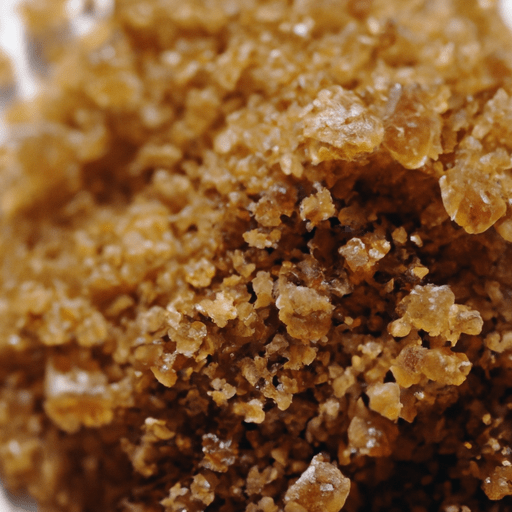The Sweet Delights of Dark Brown Sugar
If you’re a baking enthusiast or a lover of all things sweet, chances are you’ve come across the rich and aromatic dark brown sugar. This versatile ingredient is a must-have in every kitchen pantry, adding depth and complexity to a wide range of dishes. In this blog post, we’ll explore the delightful qualities of dark brown sugar: its taste, common culinary applications, nutritional value, and uncover some fascinating history and facts.
The Taste of Dark Brown Sugar
Dark brown sugar is a sweetener that boasts a distinct molasses flavor. It possesses a deep caramel and toffee-like taste, making it a prized ingredient in both sweet and savory preparations. The combination of its fine granules and sticky texture creates a delightful mouthfeel, delivering a satisfyingly sweet punch to any recipe. The molasses content found in dark brown sugar is responsible for its darker color and robust flavor profile, setting it apart from its lighter counterparts.
Culinary Applications
Dark brown sugar is a key component in a plethora of recipes, from traditional comfort foods to gourmet desserts. Its unique qualities make it an essential element in a variety of tasty treats. Let’s explore some of its most common culinary applications:
Baking Wonder
Dark brown sugar works wonders in baked goods. It adds moisture, enhances the richness of flavors, and contributes to the signature chewiness found in cookies, cakes, and brownies. The molasses content in dark brown sugar also aids in creating beautifully golden and crispy crusts on bread and pastries. The possibilities are endless when it comes to experimenting with this magical ingredient.
Irresistible Sauces and Glazes
Whether you’re making a homemade barbecue sauce or a glaze for succulent roasted meats, dark brown sugar takes flavor to new heights. Its intense sweetness, combined with its distinctive molasses undertones, adds depth and complexity to savory dishes. The caramelization process that occurs when using dark brown sugar in sauces and glazes offers a luscious, glossy finish that instantly elevates any dish.
Flavorful Marinades
Marinades are an essential tool for infusing meats, poultry, and seafood with unforgettable taste sensations. Dark brown sugar effortlessly enhances the overall flavor profile of marinades, providing a perfect balance of sweetness and subtle bitterness. Its ability to tenderize proteins, while imparting a rich caramelized essence, creates a truly memorable dining experience.
Nutritional Value
While dark brown sugar may be a delight for the taste buds, it’s important to note its nutritional components. Dark brown sugar provides a calorie-dense energy source due to its high carbohydrate content. Apart from its caloric value, it also contains trace amounts of minerals, such as calcium, iron, and potassium, which are essential for overall health. However, it’s important to enjoy dark brown sugar in moderation as excessive consumption of added sugars can have negative health implications.
History and Fun Facts
Dark brown sugar has a rich history dating back centuries. Originally prized in Asia and the Middle East, sugar production and trade eventually spread worldwide, resulting in different forms and varieties of sugar. The creation of dark brown sugar is a result of refining processes used to remove impurities from natural sugarcane or sugar beet juice. The degree of molasses left behind during this refining process determines the darkness of the sugar.
Interestingly, dark brown sugar can be easily made at home by mixing white granulated sugar with molasses. This allows you to control the intensity of flavor and color, giving you the freedom to customize your creations.
Conclusion
Dark brown sugar offers a world of culinary possibilities with its robust flavor profile and versatility in the kitchen. From its rich taste to its ability to transform mundane dishes into culinary masterpieces, this ingredient is a true staple for food enthusiasts. Whether you’re baking sweet treats or adding depth to savory dishes, embrace the sweet delights of dark brown sugar and let your palate indulge in its luscious notes. Remember, a little goes a long way, so savor it in moderation and enjoy the wonders it brings to your culinary adventures.
Dark Brown Sugar
Origin: Dark brown sugar is a type of sugar that is typically made by adding molasses back into refined white sugar. It is a common ingredient in many cuisines around the world. Molasses, the key ingredient in dark brown sugar, is made by extracting the juice from sugar cane or sugar beets and then boiling it down to a syrup.
Common Uses: Dark brown sugar is widely used in baking recipes, especially in recipes for cookies, cakes, and pies. It adds moisture, flavor, and a rich caramel-like taste to baked goods. It is also commonly used as a sweetener in beverages, sauces, and marinades.
Nutritional Benefits: Dark brown sugar, like other forms of sugar, is primarily a source of carbohydrates and calories. However, it contains small amounts of minerals like calcium, iron, and potassium due to the molasses content. Compared to refined white sugar, dark brown sugar also contains a slightly higher amount of molasses, which provides a trace amount of vitamins and antioxidants.
Unique Properties: Dark brown sugar has a moist and sticky texture due to the presence of molasses. It has a strong, distinct flavor with notes of toffee and caramel. The dark color of this sugar is a result of the molasses content, which contributes to its rich flavor and appearance.
Historical Significance: Sugarcane cultivation and the production of sugar dates back thousands of years, with origins in ancient India. The process of refining sugar from sugarcane spread across the world and became an essential global commodity. While dark brown sugar gained popularity in the 19th century, it has been used in traditional recipes throughout history as a sweetening agent.




Use the share button below if you liked it.
It makes me smile, when I see it.